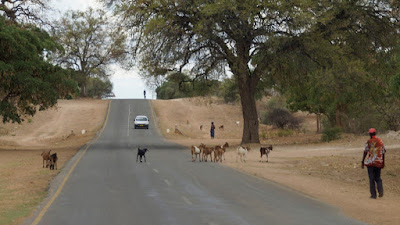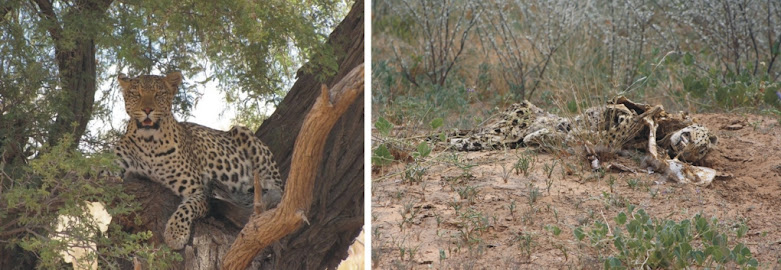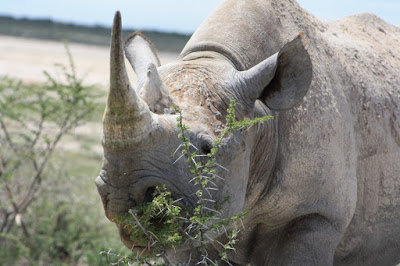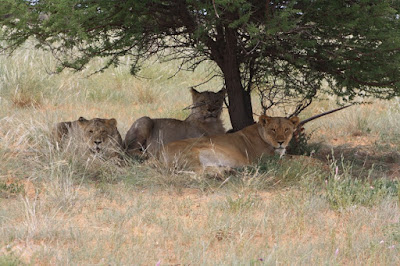 Windhoek
– Victoria Falls and back
Windhoek
– Victoria Falls and back
Before we leave the
Etosha National Park today, we take an early
morning ride around the Fischerpfanne and back to Fort Namutoni: Breakfast!
Packing, loading and
after that to the Klein-Namutoni waterhole – a lap along the Dik-Dik path and
off we go towards the Okavango River.
<<< "Kitties" close to the "Aroe" waterhole, north of the "Fischerpfanne".
We leave the national park through the "Von Lindequist Gate (also Namutoni Gate)", and from there we have to drive about 315km up to Rundu and then another twenty kilometres to the NKWAZI LODGE, which is located directly on the banks of the Okavango, which here forms the border between Namibia and Angola.
We calculate with just under four hours for the pure driving time (without breaks) and can therefore afford the time to look around the national park again after breakfast.
On the way to the mining
town of TSUMEB, we pass the only two natural lakes in Namibia.
LAKE GUINAS is with its 140 × 70 metres water surface and a
depth of about 132 metres, the largest lake in Namibia that is constantly
filled with water. This karst lake near the Guinas farm is considered as to be
a twin lake of Lake Otjikotos 15 kilometres (bee-line).
Lake Guinas was
previously used to supply water to the nearby mining town of Tsumeb by means of
a then still existing steam pumping station. Among other things, the originally
endemic cichlid species “Tilapia guinasana” occurs in Lake Guinea.
Like Lake Guinas, LAKE
OTJIKOTO is a naturally formed karst lake and thus the second of only two
lakes in Namibia that are constantly filled with water. Charles John Anderssen
and Francis Galton were the first Europeans to reach this lake in 1851. With a
size of 100 × 150 metres, its water surface is slightly smaller than that of
Lake Guinas. However, its depth has only been explored down to around 76
metres, and much of it is still in the dark - especially the transition from
the water-filled sinkhole to the suspected system of underground watercourses.
Some researchers think this system could reach up to well under the western
part of the Etosha Pan. Some other researchers even suspect that there could
also be a connection to the Dragon's Breath Cave, more than fifty
kilometres south-east of Lake Otjikoto.
Because hobby divers sometimes had fatal accidents in Lake Otjikoto during privately organized “research dive sessions”, now diving there is only permitted with official permits.
Shortly before their surrender, the German Schutztruppe sank weapons and ammunition in this lake in 1915 so that they would not be left to the enemy.
Here again
impressions from our side trip to the Klein-Namutoni waterhole and the lap
around the Dik-Dik Drive.
Our
route from Fort Namutoni to the Nkwazi Lodge and on to the Ndhovu Safari Lodge.
Along the route between Tsumeb and Grootfontein, we unfortunately had not enough time to make a detour to the Hoba meteorite. It happened because we just preferred to use this time to do a few more laps within the Etosha National Park.
<<< Short break at the Mururani
checkpoint.
In Rundu a few more errands and then it goes
straight to the NKWAZI LODGE, directly on the Okavango. When approaching our
chalets, I made a mistake on the driveway and turned a sand path too early. To
the great fun of the kitchen staff and with their active assistance, the
manager had to pull me backwards with his tractor out of the sand hole into
which I had slipped. With a vehicle that has neither all-wheel drive
nor a differential lock, you should act very carefully in the fine flour sand
if you get stuck. In the best case, you won't get free, in the worst case, you
just dig yourself deeper into the sand.

The "Hoe-poe-Welcoming Committee"... ....and the opposite bank is already part of Angola.
Later in the afternoon, we went on a boat tour
along the Okavango – and a short stopover with snacks and drinks on the Angola
side of the river. Not really completely legal - but where could we have gone big without having a vehicle on the other side of the river.
As if coming out of nowhere, a small group of local "striplings" appeared there, who (of course) offered a lot of really funny homemade souvenirs for sale. Then it's back to the lodge - and behind us a magnificent sunset over the river and savannah.
...the other side of the river - in Angola...
....on our way back to the lodge... ...but even close to the lodge - be careful!!!
We don't have that far today. So we can start the day comfortably. Round about 190km along the Okavango eastward to Bagani and from there another twenty kilometers southwards to just before the Mahango game reserve, which is part of the Bwabwata National Park.
The NDHOVU SAFARI LODGE is also located directly on the Okavango. But her it no longer forms the border with Angola. The opposite bank also belongs to Namibia (Caprivi Strip) and is also part of the Bwabwata National Park. Of course, on Monday, November 18th, we arrived<<< We pass through the small village of Bagani

<<< In front of our veranda: hippos wait for the sunset to go to the river meadows to graze when it gets dark.
at the Ndhovu Safari Lodge soon enough to do a lot more: :
- A tour in our own vehicle through the Mahango Game Reserve, ...
- ... a boat trip over the Okavango - along the banks of the Bwabwata National Park...
- ... relax in comfort at the "pool", ...
- ... and then of course a wonderful dinner, before we go over to the “cozy part” of the evening around the campfire. But more about that in the next section of the travel description.
In this blog, we not only describe the tour
itself and what we experienced. We also want to report on aspects of nature
conservation, the history of the creation of the national parks and current
events in connection with it. The present geology of the respective landscapes
and their geological history also play an important role.
Klar – wir können in diesem Rahmen nicht alles ausführlich behandeln.
Sure - we cannot deal detailed with everything in this context. Therefore my request: Write in the comment column, your personal questions, which topics you are particularly interested in and what we should write more about.
We have
also dedicated two pages to these topics on our website - namely:
- nature
conservation and hunting .... >>>
-
.... as well as nature conservation and tourism ... >>>
Current travel offers - for self-drivers as
well as guided tours
- can be found on our website: www.paarl-safari.de
- or you send us an e-mail to: info@paarl-safari.de















